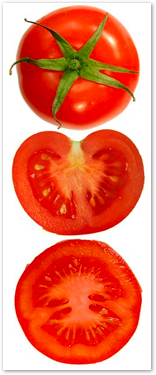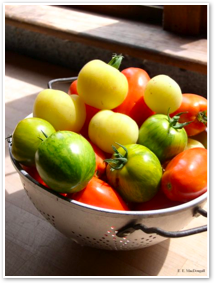
History of the Tomato:
An ancestor to the tomato, which was very large and lumpy compared to a modern day tomato, is known to have originated in the highlands of the west coast of South America. Currently, South America is the only place wild tomatoes grow.12 information has shows that the precursors to tomatoes were green plants which grew small green fruits. These plants grew in Peru, and slowly began to diversify into the many species of Solanum’s today. The tomato, Solanum lycopersicum, was taken to Mexico and it was grown and eaten by prehistoric humans, around 500BC. The exact date of when the tomato was domesticated is unknown. It is believed that the Aztecs began cooking the tomato, which was small and yellow at the time, and called it the “xitomatl,” which is pronounced zee-toe-mah-tel, and is translated to “plump thing with a naval,” The word xitomatl later became tomatl, and was believed by the Aztecs that those who witnessed the ingestion of tomato seeds were blessed with powers of divination.
In the mid 1700’s, John Gerard, from Britain, knew about the tomato usage in Spain and Italy, but still believed in the common myth of the time that tomatoes were poisonous. With time, the Encyclopedia Britannica states “the tomato was in daily use in soups, broths, and as a garnish.” In the
Middle East, the tomato was introduced by Britain, and was not consumed until the 18th century.
As for North America, William Salmon, reported the first siting of tomatoes being grown in South Carolina. These may have been introduced by the Caribbean, but today is till unclear. In the mid 1800’s the tomato was being cultivated in plantations. It is believed that people still believed that the tomatoes were poisonous, therefore tomatoes were grown for decoration and were not eaten until later.
Future of the Tomato:
The sequencing of the tomato genome began in 2004. The Boyce Thompson Institute for Plant Research began the first draft of the full genome. The mitochondria and chloroplasts are also being published as part of the research project.

Those who have ever tasted a tomato fresh from the garden definitely can tell that they just don’t taste as good as the tomatoes grown for commercial use. Because of this, Calgene took action and invented the product Flavr Savr. Before, tomatoes were picked when they were still unripe (green) and shipped around the world. Picking them this early prevented the bruising of many tomatoes, making profits much higher. When the tomatoes were delivered to the supermarkets, ethylene gas was used to ripen the tomatoes before they were put on the shelves. Flavr Savr mutates the gene in the tomato that usually caused them to become soft. Due to this, tomatoes can be left on the vine longer, which allow for more sugars to move into the tomato, giving it the fresh-from-the-garden taste! 6


Site designed by Chloe Scheel, Last updated April 2009.
From South America, the tomato was believed to be transported to Europe by the Spanish explorer Cortez, who was there to capture the Aztec city. It is also believed that Christopher Columbus, under the Spanish Monarchy, was the first to discover the tomato in 1493, one year after he was believed to discover America. With movement of the tomato from Mexico to Spain, the Spanish continued to distribute the tomato throughout their colonies in the Caribbean. The tomato was also taken to

the Philippines, which later lead to the spread of tomatoes throughout the Asian continent. In Spain, the tomato was being used as food in the 1600’s, and in 1692 the first record of a recipe book containing tomatoes was published. When they first appeared in France, tomatoes were referred to as pomme d'amour, which translates to "love apples." This name came about because of the shape and the belief that tomatoes gave an aphrodisiac feeling after consumption. Tomatoes being very uncommon, majority of people believed the tomato to be poisonous. The bright red color, formed by the pigment lycopene, caused these beliefs. In Italy, the

As a pioneer to growing the tomato in America in 1809, President Thomas Jefferson began eating tomatoes at presidential dinners in 1806. By 1820, lingering doubts about the tomatoes poisonous characteristics continued until a man by the name of Colonel Robert Gibbon Johnson ate a bushel of tomatoes in front of the Salem, Massachusetts courthouse. His survival in front of a gathering of people lead to tomatoes being a common food item in 1826. They were even believed to keep blood pure in the midst of the summer heat. As years passed, the tomato began to be known for the aphrodisiac feeling given after consumption. Today, the tomato is believed to be beneficial to the heart. 12

Christoper Columbus
Thomas Jefferson
Tomatoes need a specific growing environment for them to survive, especially if you want to get the best flavor out of them. They also have a very unique life cycle called alternation of generations. Want to learn more? Check out my page all about tomatoes!

tomato was used as a table decoration due to the belief the tomato was poisonous until the late 17th or early 18th century, when it was used in recipes and became more commonly known as the “poor mans” food.